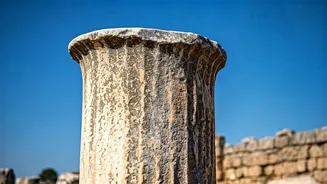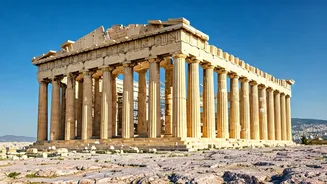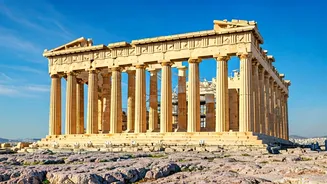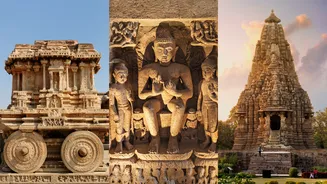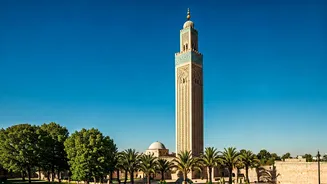Acropolis of Athens
The Acropolis of Athens, a UNESCO World Heritage site, towers over the city and is probably the most iconic ancient ruin in Greece. This magnificent complex
was the heart of ancient Athens, featuring the Parthenon, a temple dedicated to the goddess Athena. Constructed in the 5th century BC, the Parthenon's Doric columns and intricate sculptures exemplify classical architecture. Visitors are amazed by the Propylaea, the monumental gateway, and the Erechtheion, known for its Caryatids. The Acropolis served as a religious and civic center, offering insights into ancient Greek life. Today, it remains a symbol of democracy, philosophy, and art, attracting millions of visitors. Exploring its ruins offers a profound connection to the past, allowing one to appreciate the ingenuity and cultural achievements of ancient Greeks. The Acropolis is a must-see for anyone interested in history and architecture, providing a captivating experience that transports you back in time.
Delphi's Sacred Site
Delphi, located on the slopes of Mount Parnassus, was considered the center of the world by the ancient Greeks. Famous for its oracle, who provided guidance on important decisions, Delphi held significant religious and political influence. The sanctuary of Apollo, the god of music, healing, and light, drew pilgrims from across the ancient world. Visitors can explore the Temple of Apollo, the Athenian Treasury, and the ancient theater. The ruins reveal a carefully planned layout, showcasing the impressive engineering and artistic skills of the time. The stadium hosted athletic competitions as part of the Pythian Games. The archaeological site provides a unique glimpse into ancient religious beliefs, rituals, and the importance of prophecy. The site's dramatic mountain setting enhances its spiritual atmosphere. Walking through Delphi, you can almost hear echoes of ancient chants and the whispers of the oracle, offering a profound journey through time and spirituality. Its historical importance and stunning landscape make it a remarkable place to explore.
Ancient Olympia's Legacy
Olympia, in the Peloponnese, is the birthplace of the Olympic Games, a celebration of athletic prowess and religious significance. The ancient site includes the Temple of Zeus, once housing a massive statue of Zeus, one of the Seven Wonders of the Ancient World. The ruins also feature the remains of athletic facilities, such as the stadium, hippodrome, and gymnasium. The games were a crucial part of Greek identity, bringing city-states together in peaceful competition. The site’s historical significance is immense, offering insight into the organization, rituals, and spirit of the games. Walking through Olympia, you can feel the energy of past athletes and the pride of ancient civilizations. The archaeological museum houses impressive collections of artifacts discovered at the site. A visit to Olympia is a truly immersive experience that brings you closer to the origins of sports and the ideals of fair play. The site’s influence continues to inspire athletes and sports enthusiasts worldwide.
Knossos' Minoan Palace
The Palace of Knossos, located on Crete, is one of the most important archaeological sites of the Minoan civilization. The palace, with its intricate architecture, elaborate frescoes, and sophisticated infrastructure, showcased the advanced civilization of the Minoans. The site includes multiple levels, winding corridors, courtyards, and rooms. Visitors can explore the Throne Room, the Grand Staircase, and the Queen’s Megaron, adorned with vibrant murals. Knossos offers a window into Minoan culture, including their art, religion, and social organization. The site's legends, such as the Minotaur and the labyrinth, add an air of mystery. Exploring Knossos provides a unique perspective on the Minoan world, revealing a civilization that flourished thousands of years ago. The palace's grandeur and advanced design underscore the Minoans' significant influence. Discovering Knossos is a compelling journey back in time, allowing you to witness the accomplishments of a fascinating society.
Ancient Agora in Athens
The Ancient Agora in Athens served as the heart of ancient Athenian life. It was a bustling marketplace, a center of political activity, and a place where citizens gathered. The Agora was where public speeches were delivered, trials were held, and business transactions took place. Key structures include the Temple of Hephaestus, well-preserved among ancient Greek temples. Also worth exploring are the Stoa of Attalos, now a museum displaying artifacts from the site, and the Bouleuterion, where the council of 500 met. The Agora played an essential role in the development of democracy and philosophical thought. Exploring the ruins provides a fascinating perspective into the daily life of ancient Athenians. The site's historical significance is immense, demonstrating the importance of public spaces in democratic societies. A visit to the Agora is a great way to understand ancient governance and social interactions. The Agora remains a vibrant reminder of the birth of democracy and the significance of civic life.
Epidaurus' Healing Sanctuary
Epidaurus, a sanctuary dedicated to Asclepius, the god of healing, was a significant center for ancient medicine. The site includes the well-preserved ancient theater, famous for its excellent acoustics, and the Temple of Asclepius. Visitors can explore the ruins of healing facilities, such as the Enkoimeteria, where patients sought medical treatment. The theater, with a capacity of thousands, hosted dramatic performances. The site exemplifies ancient Greek advancements in healthcare, with the aim of physical and spiritual healing. The archaeological museum houses medical instruments and votive offerings. A visit to Epidaurus offers insights into ancient medical practices and beliefs in the power of healing. The theater remains a marvel of engineering, still used for performances today. Epidaurus showcases how the ancient Greeks valued health and well-being. This site is a testament to the blend of spirituality and medicine in ancient times.
Mycenae's Citadel Walls
Mycenae, a prominent Bronze Age civilization, is famous for its massive Cyclopean walls and its significant role in Greek mythology. The site’s archaeological treasures include the Lion Gate, the entrance to the citadel, and the Treasury of Atreus, an impressive tholos tomb. The palace complex reveals the power and wealth of the Mycenaean rulers. Visitors can also explore the Royal Grave Circle and other burial sites. Mycenae's historical significance lies in its military prowess and its impact on the development of early Greek culture. The site is a reminder of the legends of Agamemnon and the Trojan War. Walking through Mycenae, one can feel the echoes of ancient battles and the grandeur of a powerful civilization. Exploring the site, one can discover the rise and fall of ancient kingdoms and their lasting influence on history. Its ruins offer a compelling glimpse into a bygone era of conflict, conquest, and architectural innovation.
Ancient Corinth's Remains
Ancient Corinth, a prosperous city in ancient Greece, offered insights into trade, commerce, and culture. The site showcases the Temple of Apollo, a significant religious structure, and the ruins of the Roman forum, the center of public life. Other important sites include the Acrocorinth, a vast acropolis offering panoramic views, and the Lechaion Road, a major thoroughfare. The site offers glimpses into both Greek and Roman influences. It showcases a thriving city known for its strategic location, which made it a hub for commerce. Exploring Corinth provides a unique understanding of the interaction between various civilizations. The archaeological museum contains artifacts discovered at the site. A visit to Corinth provides a fascinating glimpse into the evolution of ancient societies. Corinth's vibrant history and its diverse influences make it a must-see for anyone interested in the legacy of ancient Greece.
